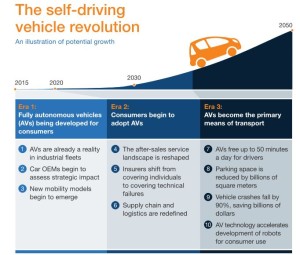The self-driving or autonomous vehicle (AV) for consumers is coming. If the recent Canadian Connected Car Technology Roadshow brought to Silicon Valley by the AutoTech Council is any indication, Canada is vying to be at the forefront.
At this event, attendees got a chance to look under the hood and discuss what issues are driving the future of the Connected Car industry. This Roadshow is a partnership between the Automotive Parts Manufacturers’ Association (APMA), whose members account for over 90% of independent parts production in Canada (a $30 billion industry), and the Canada Trade Commissioner Service in Silicon Valley. APMA also brought its Lexus RX350 connected vehicle demonstrator to Silicon Valley to showcase a sample of what they have to offer to the Internet of Things (IoT), Automotive, and Telecom industries.
On April 28, 2015, General Motors (GM) announced that it will significantly expand its Canadian Engineering Centre in Oshawa, Ontario into an “innovation hub” for connected car and green vehicle technology research and development. Following the new connected-vehicle and green tech mandate, GM’s Canadian Engineering Centre is hiring 100 engineers.
In his keynote address during the Roadshow event, Brian Tossan, Director at GM’s Canadian Engineering Centre, presented where GM is heading on the connected car front and how the Canadian team, including its network of local suppliers and universities, fits into the mix. His talk covered some key trends:
- In 2015 the # of connected “things” will increase 30% to 4.9 billion (Gartner)
- 1 in 5 cars globally will have wireless connectivity by 2020 (Gartner)
- 75% of GM customers will be connected in 2020 (GM)
- 50% consider connected car features to be key purchase considerations (Telefonica)
- Cisco by 2025 auto generated big data will be worth $122 billion (Cisco)
According to a June, 2015 McKinsey article, 10 Ways Autonomous Driving Could Redefine the Automotive World, the development of self-driving, or autonomous, vehicles is accelerating. Here’s how they could affect consumers and companies.
 The self-driving car has strong potential for improving traffic flow, road safety, and reducing the environmental impact of traffic. But only if it is designed to communicate with other cars and smart road systems. The new ecosystem includes the car itself, devices, infrastructure and the external environment outside the car (the community). The new supply chain will require strategic partnerships, traditional and non-traditional, with many technologies, products, and companies in both the public and private sector to make solutions for the new generations of connected cars a reality.
The self-driving car has strong potential for improving traffic flow, road safety, and reducing the environmental impact of traffic. But only if it is designed to communicate with other cars and smart road systems. The new ecosystem includes the car itself, devices, infrastructure and the external environment outside the car (the community). The new supply chain will require strategic partnerships, traditional and non-traditional, with many technologies, products, and companies in both the public and private sector to make solutions for the new generations of connected cars a reality.This raises many questions and issues to be resolved. Who will invest in the new infrastructure to support the connected car? For example, installing new smart traffic lights and data infrastructure at the street level to enable controlling efficiency of traffic flow while reducing emissions and travel time will require a cooperative partnership and investment from state, municipal and private entities.
An Advanced Communication Network Will Be Required
Today, the connected car can do a lot, from reporting location to remote door unlock. Compared to what is coming in the connected and autonomous cars of the future, it is very low tech, so 2G and 3G networks work well enough today. Car manufacturers are working with carriers around the world to address the challenge of infrastructure of car connectivity to the internet. One of the key goals will be to minimize a lot of network traffic. This will require intelligent management of infrastructure (including cell towers), to stagger downloads and enable least cost routing.
The life cycle of a car spans about 10 years and the connected car will require a flexible platform for the life of the car that support a 3G, 4G, 5G, LTE wifi, blue tooth, and Dedicated Short Range Communication (DSRC) amalgamation. There is also the issue of rural areas with no connectivity, and cable companies with large footprints may provide part of the solution.
In addition, the customer is decoupling the car from the carrier. Cars won’t be locked the way cell phones often are today. Solutions will need to address issues like how do you manage three radios in the car (including your key fob, smart watch, wireless charger, etc.) and ensure they don’t interfere with one another? Cars need to be capable of multiband and will be able to go to different frequencies in different countries through the use of soft SIM technology.
As wireless technologies in connected cars evolve, vehicles will become nodes on the larger Internet, sending vast amounts of information to the cloud where it can be shared with your mechanic, your smart phone, apps and other cars. Car and tech companies must consider and account for the large amount of data these sensors and devices will collect, and how they can use that information to make additional improvements and services available, while securely protecting the data and the driver.
Car to Cloud
During the event, a moderated panel discussed how the Cloud would augment the car. To summarize, the car becomes just a data center on wheels and computing is pushed to the cloud. Given the amount of power, space, energy required, the Cloud becomes the most economic place. Another benefit, the Cloud can learn, making better decisions in the autonomous car. The car can be updated more frequently, such as with navigation systems. With car as sensor and everything else coming from the cloud, it is analogous to how your smart phone works. When the connection isn’t there, it is always backing up the system.
Data analytics and contextual data in the cloud will enable the ability to look at things like a set of vehicles, or all vehicles, or a set of people and pulling and reporting data from the car could become a recurring revenue source.
The automotive industry and supporting solution ecosystem providers are clearly in the process of rethinking the future for connectivity and services as well as their vision for monetizing. Future KPIs may not only be measured by share of vehicles on road but metrics like miles traveled and bytes consumed.
Connected Car Solution Providers at the Roadshow
Companies with technologies involved in this Canadian Connected Car Technology Roadshow event gave Rapid Fire Demo presentations about software and hardware solutions to address some of these challenges in bringing the next generations of the connected and autonomous car to market and are listed here:
• Alcohol Countermeasure Systems
• BRAKERS Early Warning Systems
• CGI Group
• Intelligent Mechatronics Systems (IMS)
• Invotek Electronics
• Leggett & Platt Automotive
• Litmus Automation
• Lixar IT
• Phantom Intelligence
• Pravala Networks
• QNX Software
• Studio 63
• TE Connectivity Canada
• TrustPoint Innovation
• Weather Telematics
• XYZ Interactive


